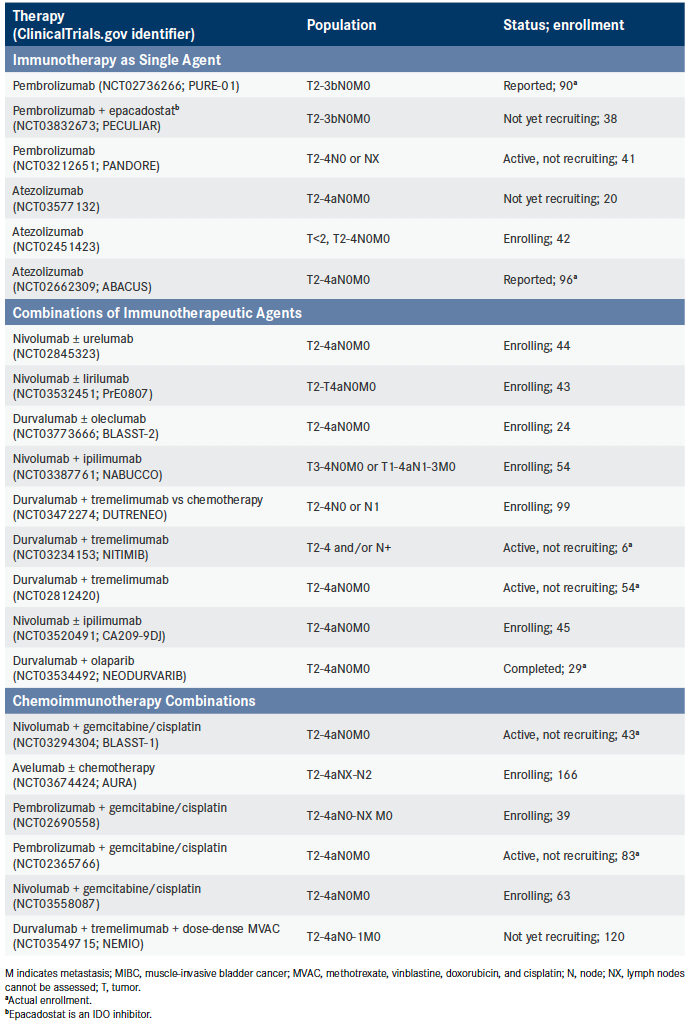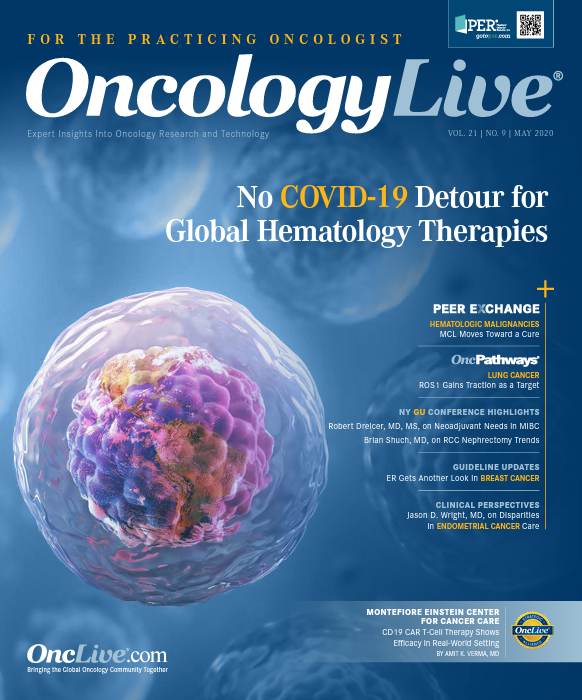Publication
Article
Oncology Live®
Immunotherapy Regimens May Expand Use of Neoadjuvant Therapy in MIBC
Author(s):
Although the standard of care for muscle-invasive bladder cancer is well established, not enough patients are being treated with curative intent.
Robert Dreicer, MD

Robert Dreicer, MD
Although the standard of care for muscle-invasive bladder cancer (MIBC) is well established, not enough patients are being treated with curative intent, according to Robert Dreicer, MD, MS. Now, Dreicer said, a new paradigm that includes neoadjuvant use of immune checkpoint inhibitors may be emerging, but the impact of fresh approaches in the neoadjuvant setting will hinge on whether clinicians and patients embrace change.
"The data that we [have] in the neoadjuvant setting has been known to us for 30 years, and the uptake broadly in the community has been problematic," said Dreicer, deputy director of the University of Virginia Cancer Center in Charlottesville. "But we are also moving into a new era, hopefully, of the management of urothelial cancer, which includes the neoadjuvant setting."1
Dreicer discussed current and future approaches in MIBC during a presentation at NY GU 13th Annual Interdisciplinary Prostate Cancer Congress® and Other Genitourinary Malignancies hosted by Physicians’ Education Resource®, LLC, which was held as a virtual meeting due to the coronavirus disease 2019 pandemic. He also serves as director of solid tumor oncology in the division of Hematology/Oncology and is a professor of medicine and urology at the University of Virginia.
As it stands now, Dreicer said, there is a disconnect in the treatment of patients with MIBC. The standard of care for patients with MIBC is neoadjuvant cisplatin-based chemotherapy followed by radical cystectomy (RC). If patients are not eligible for cisplatin treatment, they should either proceed to RC or be enrolled in a clinical trial evaluating an immune-oncology therapy.
However, Dreicer cited a recent analysis by Ralph de Vere White, MD, and colleagues that detailed f indings from 2 studies showing that many patients do not receive the standard of care treatment. In 1 study involving 28,691 patients with MIBC in the National Cancer Database, where 80% of patients are treated in academic centers, 41.3% underwent RC, while 7.6% received definitive radiotherapy. Another study used information from the Surveillance, Epidemiology, and End Results Program database, which is more reflective of the general population, to examine care given to 3205 Medicare patients with stage II organ-confined nonmetastatic urothelial carcinoma. Of these patients, 21% underwent RC, whereas 51% received surveillance, resulting in 5-year overall survival rates of 42% and 14.5%, respectively.2
The studies suggest a "significant undertreatment" of patients with MIBC, a population with a median age in the low- to mid-70s. "This underutilization of radical cystectomy is representative of perhaps not just an aging population but [also] a mindset about who can be managed with curative intent."
First-line treatment with cisplatin-based chemotherapy followed by RC was established through a phase 3 trial in patients with stage T2 to T4a MIBC who were randomized to receive RC alone or with 3 cycles of prior cisplatin-based chemotherapy of methotrexate, vinblastine, doxorubicin, and cisplatin (MVAC).
Patients treated with the MVAC combination (n = 153) had a median overall survival of 77 months versus 46 months in the RC-alone arm (n = 154; P = .06). Those who received RC alone had a 33% greater risk of death than those in the MVACplus-RC group (HR, 1.33; 95% CI, 1.00-1.76). In addition, of the 126 patients in the MVAC group who underwent RC, 38% of the surgical specimens were pathologically free of cancer at the time of surgery; 85% remained alive at 5 years.3
Findings from multiple studies conducted over the years confirm the absolute benefit of cisplatin-based chemotherapy is probably in the 10% to 15% range, Dreicer said. "The data have been available to us for 25 to 30 years. Despite that, its uptake broadly in both the community and, to some extent, within the academic medical centers has been less than perhaps we would like," he said. “We all recognize the challenges. There are concerns about tolerability; some-times, there are concerns about moving ahead rapidly with surgery."
Dreicer said any cisplatin-based chemo-therapy regimen is acceptable in patients who are fit to receive it. "This is a very lethal disease and even though neoadju-vant cisplatin-based chemotherapy is a modest benefit, a 5% to 15% improvement in survival is not modest if you are 1 of those 5% to 15% of patients," he said. "This is a well-trodden pathway; we know how to give this therapy safely and effectively, and it remains the standard of care until we evolve beyond that."
Evaluating Patients for Neoadjuvant Therapy
Patients who are deemed unfit for treatment with standard-of-care cisplatin meet 1 or more of the following criteria: Eastern Cooperative Oncology Group performance status of 2 or greater or a Karnofsky Performance Status Scale score of 60% to 70%, creatinine clearance less than 60 mL/min, grade ≥2 hearing loss, grade ≥2 neuropathy, and/or New York Heart Association Class III heart failure.4 Some academic centers are willing to treat patients with creatinine levels in the 50 mL/min range, sometimes with changes in cisplatin dosing, Dreicer said.
For patients who fit 1 or more of these criteria, immune checkpoint inhibitors may hold the most promise as future neoadjuvant treatment, according to Dreicer. Five agents that inhibit the PD-1/PD-L1 checkpoint are approved for patients with locally advanced or metastatic urothelial carcinoma; 1 of these drugs, pembrolizumab (Keytruda), is also indicated in patients with high-risk nonmuscle-invasive bladder cancer unresponsive to bacillus Calmette-Guérin therapy. Dreicer highlighted trials with the potential to change the neoadjuvant standard of care (Table).5
Table. Ongoing Phase 1/2 Trials Evaluating Neoadjuvant Therapy in MIBC5 (Click to Enlarge)

Atezolizumab (Tecentriq) is being examined as a neoadjuvant option in the phase 2 ABACUS trial (NCT02662309). Ninety-five patients received 2 cycles of atezolizumab at a dose of 1200 mg every 3 weeks. Regardless of PD-L1 status, the pathological complete response rate was 31% (95% CI, 21%-41%).6 In previously reported data of 68 patients, 39% of patients were downstaged to nonmuscle invasive disease.1
“These are small studies, but they suggest that there is the potential for significant utility of checkpoint inhibitor therapy,” Dreicer noted. He added that some patients in the pembrolizumab study were eligible to receive cisplatin, making the decision whether to enroll participants in trials “somewhat controversial.”
“One of the questions that remains is whether or not the responders represent similar patients who might respond to cisplatin neoadjuvant therapy. If we identify the same group of patients who respond, we would still potentially be offering less-toxic therapy,” he said. “Our priority is identifying biomarkers to guide whether or not a chemotherapeutic neoadjuvant therapy is better for patient X versus patient Y, remains to be seen.”
The phase 3 ENERGIZE trial (NCT03661320) is an ongoing 3-arm study comparing chemotherapy with gemcitabine and cisplatin alone, in combination with the anti—PD-1 agent nivolumab (Opdivo) plus placebo, or with nivolumab plus linrodostat mesylate (BMS-986205), an IDO1 inhibitor. After neoadjuvant therapy, all patients will undergo RC, followed by similar adjuvant treatment for those in the 2 nivolumab arms. The combination of nivolumab and linrodostat showed a favorable safety and efficacy profile in heavily pretreated patients with advanced bladder cancer in a prior phase 1/2 study (NCT02658890).7
These data are encouraging, Dreicer said, but he acknowledged that change to the standard of care is not going to occur overnight. “We’re going to look at new data that may change the paradigm and may make this a far less challenging kind of therapeutic intervention, but until that data become standard of care, we are left with what we need to do tomorrow. And what we need to do tomorrow is use cisplatin-based chemotherapy in the settings that we can.”
Dreicer noted that there are many unanswered questions about using immunotherapy regimens in the neoadjuvant setting. “All of these issues will present us with challenges, but they will be nice challenges to have, given the fact that we have not moved forward in a long period of time,” Dreicer concluded. “Neoadjuvant paradigm management is moving rapidly, hopefully to a new place.”
References
- Dreicer R. Management of muscle-invasive bladder cancer. Presented at: 13th Annual Interdisciplinary Prostate Cancer Congress® and Other Genitourinary Malignancies hosted by Physicians’ Education Resource®, LLC (PER®); March 13-14, 2020; New York, NY.
- de Vere White R, Lara PN Jr, Black PC, Evans CP, Dall’Era M. Framing pragmatic strategies to reduce mortality from bladder cancer: an endorsement from the Society of Urologic Oncology [published online January 17, 2020]. J Clin Oncol. doi: 10.1200/JCO.19.01731
- Grossman HB, Natale RB, Tangen CM, et al. Neoadjuvant chemotherapy plus cystectomy compared with cystectomy alone for locally advanced bladder cancer. N Engl J Med. 2003;349(9):859-866. doi: 10.1056/NEJMoa022148
- Galsky MD, Hahn NM, Rosenberg J, et al. Treatment of patients with metastatic urothelial cancer "unfit" for cisplatin-based chemotherapy. J Clin Oncol. 2011;29(17):2432-2438. doi: 10.1200/JCO.2011.34.8433
- Sonpavde G, Necchi A, Gupta S, et al. ENERGIZE: a phase III study of neoadjuvant chemotherapy alone or with nivolumab with/without linrodostat mesylate for muscle-invasive bladder cancer. Future Oncol. 2020;16(2):4359-4368. doi: 10.2217/fon-2019-0611
- Powles T, Kockx M, Rodriguez-Vida ALuke JL, et al. Clinical efficacy and biomarker analysis of neoadjuvant atezolizumab in operable urothelial carcinoma in the ABACUS trial. Nat Med. 2019;25(11):1706-1714. doi: 10.1038/s41591-019-0628-7
- Luke J, Tabernero J, Joshua A, et al. BMS-986205, an indoleamine 2, 3-dioxygenase 1 inhibitor (IDO1i), in combination with nivolumab (nivo): updated safety across all tumor cohorts and efficacy in advanced bladder cancer (advBC). J Clin Oncol. 2019;37(suppl 7; abstr 358). doi: 10.1200/JCO.2019.37.7_suppl.358
The phase 2 PURE-01 trial (NCT02736266) is examining the benefit of neoadjuvant pembrolizumab in patients with MIBC who had residual disease after transurethral resection and are eligible for RC. A total of 50 patients received 3 cycles of pembrolizumab at 200 mg every 3 weeks prior to surgery. The pathological complete response rate, the primary end point, was 42% (95% CI, 28.2%-56.8%). Disease downstaging was also observed to clinical stage lower than T2 in 54% of patients (95% CI, 39.3%-68.2%), which Dreicer said is in the “ballpark of cisplatin.”1










